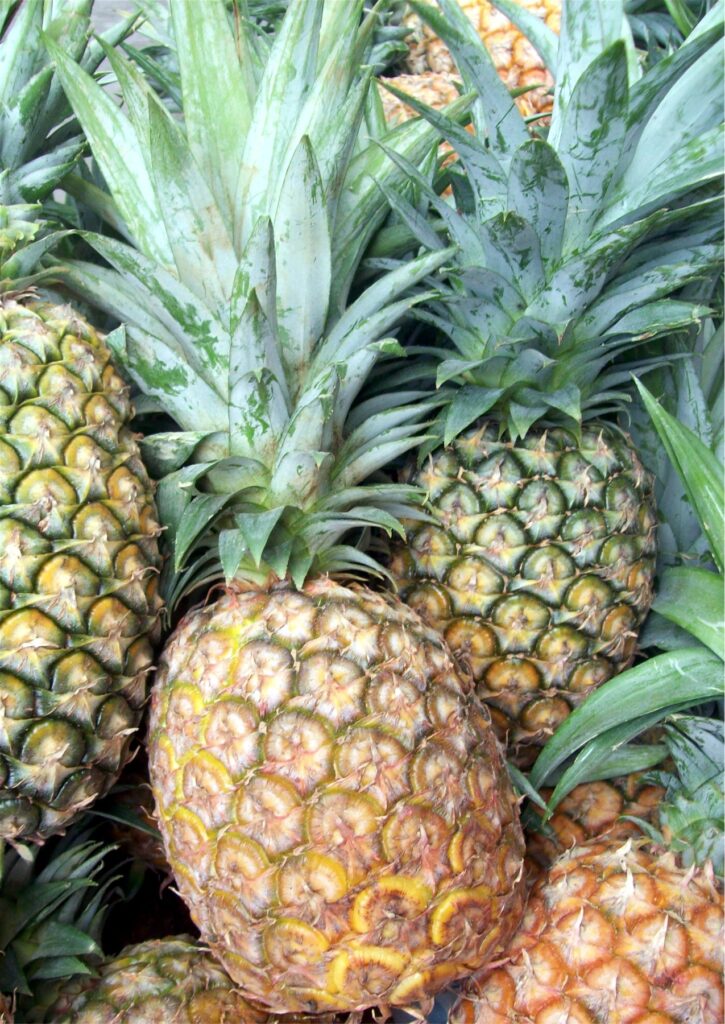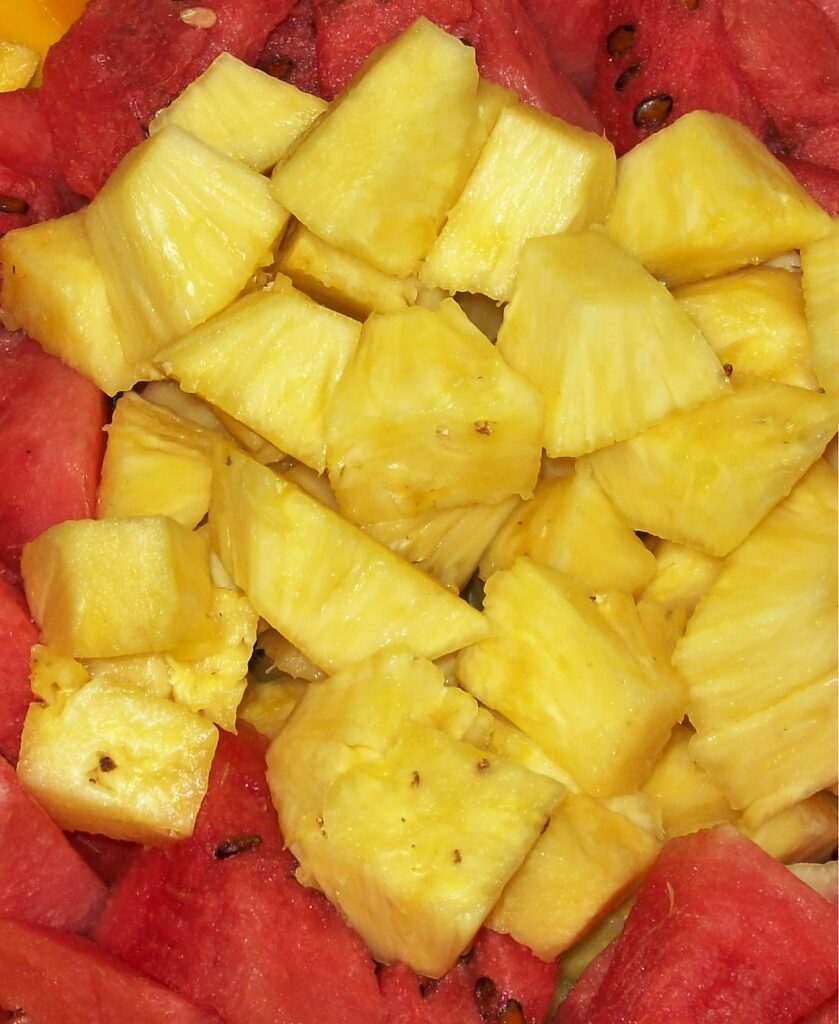Text and Photo by Henrylito D. Tacio
The pineapple, known in the science world as Ananas comosus, is one of the most exotic fruits in the world. Ripe pineapple – 85% water and 15% sugar – is rich in vitamin C, minerals, fiber, and carotene. It’s no wonder why it is very saleable all over the globe.
Christopher Columbus and his crew were the first Europeans to taste the pineapple. In 1493, they landed on the island of Guadeloupe, where they found a fruit that “astonished and delighted them.” When they returned home, they carried it with them to Spain, and before long, it was spread around the world on sailing ships that carried it for protection against scurvy. The Spanish introduced it into the Philippines and may have taken it to Hawaii and Guam early in the 16th century.
In the Philippines, pineapple is the third most widely grown fruit – after banana and mango. Most of the pineapple plantations can be found in Northern and Southern Mindanao, the Tagalog region, Western Visayas, Cagayan Valley, the Bicol region, and Negros Oriental.
The Philippines is one of the world’s leading pineapple exporters; in fact, it is the second world exporter – after Costa Rica, according to the Food and Agriculture Organization (FAO) of the United Nations.
In 2019, the country shipped over 600,000 metric tons of pineapple. FAO noted that “Philippine fresh pineapple exports in 2019 expanded by 50% to 667,633 tons, from 447,570 tons in 2018.”
The same report noted that the Philippines cornered 21% of the global pineapple trade in 2019. Costa Rica, which shipped nearly 2 million tons, was still the world’s top exporter of pineapple in 2019.


Pineapple
Some of the world’s biggest pineapple plantations (Del Monte and Dole) are found in the country.
Most of the active pineapple plantations in the country, however, are classified as being small, with a total size of 2 hectares or less. This means outside of the major tropical fruit brands that are active in the country, “the average pineapple plantation owner is catering to the local market,” reports the Food and Fertilizer Technology Center.
There are several kinds of pineapple grown in the country, among them: “Cabezona,” “Hawaii,” “Hilo,” “Singapore Spanish,” “Sugar Leaf,” Natal Canning,” and “Bogor.” The commercial varieties, however, are “Smooth Cayenne,” “Queen” (Formosa), and “Red Spanish” (Native Philippine Red).
“Smooth Cayenne” is the most favored kind for canning and fresh fruit consumption. Its flesh is yellow and very juicy. The shape is cylindrical, with a greater diameter near the base than near the top.
When ripe, the shell of the “Queen” is golden yellow, and the internal flesh is deep golden yellow. Its flesh is less juicy than the “Smooth Cayenne,” but it’s crisp, less fibrous texture, pleasant aroma, and mild flavor are unsurpassed for home use.
The fruit flesh of “Red Spanish” is more fibrous than the “Smooth Cayenne,” which is pale yellow and has a pleasant penetrating aroma and spicy, acid flavor. The core of the fruit is relatively large.
When pineapple was brought to the Philippines, no one knew. “It is not known when it was brought to the Philippines by the Spaniards,” filipinoyum.blogspot.com noted. “During the Galleon Trade, ships from Mexico carried many plants and products from America; among them was pineapple.”
The variety first cultivated in the country was Red Spanish. In 1911, the Smooth Cayenne was introduced by the then Bureau of Agriculture.
Since then, growing pineapple in the country has proliferated. The good thing about pineapple is that it can be grown even right in the backyard. Pineapple grows in areas with mild and relatively uniform temperatures throughout the year. It also requires evenly distributed rainfall during its growing period.
Studies have shown that too much shade slows the growth and results in small fruits of poor quality, while too much sunshine may cause sunburn, which injures mature fruits. As for the soil, pineapple does grow on a wide range of soil types but cannot tolerate “wet feet,” so that it can only be grown successfully in well-drained soils.
In some parts of Mindanao and in Cavite, pineapple is grown as an intercrop of coconut, coffee, papaya, and black pepper.
Harvesting pineapple is a year-round experience. For smaller farms, the peak time for harvest is usually April to July.
But “you don’t harvest pineapple anytime,” the Laguna-based Philippine Council for Agriculture, Aquatic and Natural Resources Research and Development (PCAARRD) reminds. “Harvest only when pineapple fruits are fully matured.”
Care should be taken so that the fruits are not injured while harvesting. To determine maturity, the following shell colors are used as guidelines, as suggested by PCARRD’s Philippines Recommends for Pineapple:
No. 0 – all eyes are totally green with no trace of yellow; No. 1 – 20 percent of the eyes are predominantly yellow; No. 2 – 20-40 percent of the eyes are predominantly tinged with yellow; No. 3 – 40-55 percent of the eyes are predominantly tinged with yellow; No. 4 – 55-90 percent of the eyes are fully yellow; No. 5 – 90 percent are fully yellow, but more than 20 percent of the eyes are reddish-orange; No. 6 – 20-100 percent of the eyes are predominantly reddish-brown; and No. 7 – the shell is predominantly reddish-brown and shows signs of deterioration.
“For distant markets, harvest fruits that belong to Nos. 0 to 1; for canneries, fresh consumption, and interisland shipment, Nos. 2 to 4; for processing, Nos. 5 to 6,” the PCARRD publication recommends.
Pineapple has many uses. The leaves are the source of a lustrous transparent fabric, the famous piña cloth of the Philippines, which is made into “barong” and blouses and dresses for women. A special kind of paper, thin and pliable with a smooth surface, is also made from the leaves.
“Weaving of piña cloth is a traditional industry in the Philippines,” states the filipinoyum.blogspot.com. “There was a time when weaving piña cloth was done mostly in the country. During the Spanish period, embroidered piña handkerchiefs and pañuelos, together with the elegant camisas for women and the barong Tagalog, were regarded fashionable wear for the rich.”
Processing pineapple into vinegar is a good way of turning overripe, blemished, or surplus fruits, discarded cores, peels, and trimmings into money. Although not as popular as coconut vinegar, pineapple vinegar is already being exported in small quantities. Pineapple vinegar can be produced by alcohol and acetic acid fermentation.
By-products of pineapple processing – even the skin – can be pulped and dried for livestock feeds.
As human food, the fruit can be made into a variety of products – wine, jam, nata de piña, frozen pineapple, dehydrated pineapple, candied pineapple, pineapple preserve, and marmalade.
The ripe fruit may be served as raw sliced pineapple. And all Filipinos are familiar with the refreshing drink called pineapple juice.
Processed pineapple products are doing well in the market, locally and internationally. Pineapple juice, pineapple in syrup, and pineapple jam are some of the pineapple products doing well abroad.

